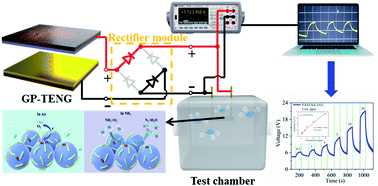An eco-friendly gelatin based triboelectric nanogenerator for a self-powered PANI nanorod/NiCo2O4 nanosphere ammonia gas sensor†
Abstract
It is of great significance to develop low-cost, eco-friendly backup power sources for driving gas sensors. In this work, a gas sensor based on the PANI/NiCo2O4 composite was driven by a gelatin-polyimide based triboelectric nanogenerator (GP-TENG) for the detection of NH3 at room temperature. Nanostructured gelatin films prepared with abrasive paper as the template dramatically enhanced the output performance of the GP-TENG and showed excellent degradability in water. The peak-to-peak voltage of the GP-TENG could reach 400 V, and the output power could reach 6.16 mW. The GP-TENG could not only drive low-powered electronic devices such as LEDs and calculators, but also could perform motion detection, such as finger touch, elbow bending, etc. A circuit module of rectification and voltage regulation was designed to convert AC voltage from the GP-TENG into stable 24 V DC voltage, which could provide constant voltage input for the gas sensor. The GP-TENG, the circuit module of rectification and voltage regulation, and the PANI/NiCo2O4 gas sensor were integrated to construct a GP-TENG-driven ammonia gas sensor (GPAS). The GPAS exhibits excellent response (Vg/Va = 467%@20 ppm) towards NH3 sensing, and also shows good repeatability, selectivity and long-term stability. This work provides an eco-friendly and economical solution to fabricate a reliable backup power source to achieve self-powered function for NH3 gas sensors, which paves the way for the construction of a “smart factory” in the future.

- This article is part of the themed collection: 2023 Journal of Materials Chemistry A Lunar New Year collection


 Please wait while we load your content...
Please wait while we load your content...